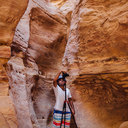2 Likes
NASA's Mars Exploration Program (Image credit: NASA/JPL-Caltech/MSSS)
Sols 3069-3070: Smile!
The images for panorama obtained by the rover's taken by the rover's Mars Hand Lens Imager (MAHLI). The mosaic, which stretches about 30,000 pixels width, includes 60 images taken on Sol 3070 (March 25, 2021).
With a successful drill campaign at “Nontron” in the books, the team continued to wrap up drill hole observations and also grab some final observations of the interesting materials that mark this area. ChemCam will acquire a passive spectra of sulfate-bearing buttes beckoning to us from farther up "Mount Sharp." Mastcam will image the sand targets “Thenac” and “Thenon” to look for wind-induced changes, and the target “Creyssac,” a coherent crack in nearby sand to watch how - or if - it changes. Mastcam and Navcam will both monitor the amount of dust in the atmosphere, and Navcam will acquire a movie looking for dust devils. RAD, REMS, and DAN maintain their steady watch over the Gale crater environment through the plan. MAHLI will image both spots that APXS analyzed on the pile of discarded Nontron drill sample in the last plan.
After the Nontron sample, MAHLI will team up with APXS for a multi-spot analysis, or raster, on the “Chassenon” target. We most commonly associate rasters with ChemCam, as moving through multiple spots in succession - sometimes in a grid, sometimes in a line - is how ChemCam analyzes a given target. Such rasters take 20-30 minutes, depending on the number of points in the raster. A raster with APXS and MAHLI takes much longer! MAHLI and APXS are both at the end of the rover arm, so each MAHLI image and each APXS analysis relies on the arm and turret to gently and accurately place the instruments where the science team wants them to go. Those arm motions are slow and careful, as you would expect if you were operating a 2-meter long arm weighing nearly 100 kilograms! The resulting data, though, make the effort worth it. The Chassenon target is the white-gray-white striped feature at the edge of the bedrock block to the left of the drill hole in the image above. If we only obtained a single APXS analysis over the center of Chassenon, the resulting chemistry would be a mix of that of the feature, the sand to its left, and the bedrock to its right. By adding two additional analyses - one slightly shifted off the center to get a mix of the feature and the surrounding bedrock, one over only bedrock - we can better isolate the chemistry of the feature. That is done by combining the chemistry from the APXS analyses with the proportions of materials in each APXS field of view, as determined with the MAHLI images that accompany each APXS analysis. The manner in which the chemistry varies with those proportions allows the chemistries of the individual materials to be separated.
We anticipate leaving our Nontron drill site in the next few sols, and just as you might snap one last picture of a memorable vacation spot, MAHLI will wrap up the plan with a rover selfie featuring the spectacular “Mont Mercou” in the background. Smile, Curiosity!
by Michelle Minitti
Other panoramas of Mars by Curiosity rover:
...





The planet Earth has proven to be too limiting for our awesome community of panorama photographers. We're getting an increasing number of submissions that depict locations either not on Earth (like Mars, the Moon, and Outer Space in general) or do not realistically represent a geographic location on Earth (either because they have too many special effects or are computer generated) and hence don't strictly qualify for our Panoramic World project.But many of these panoramas are extremely beautiful or popular of both.So, in order to accommodate our esteemed photographers and the huge audience that they attract to 360Cities with their panoramas, we've created a new section (we call it an "area") called "Out of this World" for panoramas like these.Don't let the fact that these panoramas are being placed at the Earth's South Pole fool you - we had to put them somewhere in order not to interfere with our Panoramic World.Welcome aboard on a journey "Out of this World".